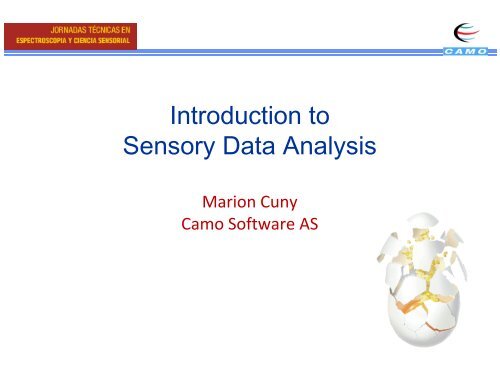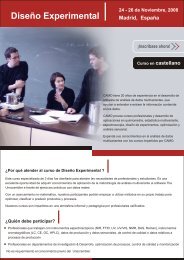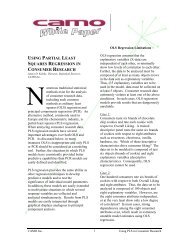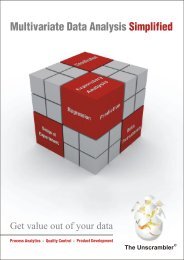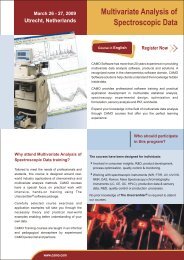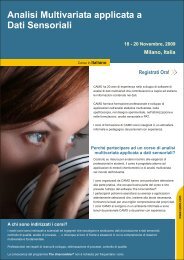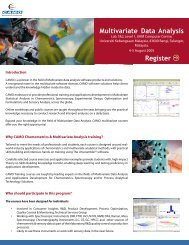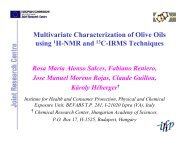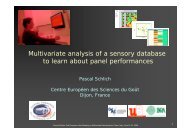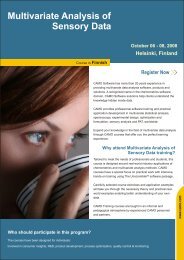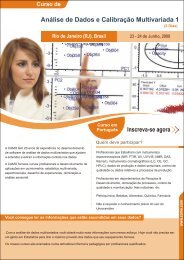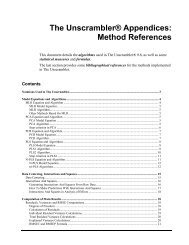Introduction to Introduction to Sensory Data Analysis - Camo
Introduction to Introduction to Sensory Data Analysis - Camo
Introduction to Introduction to Sensory Data Analysis - Camo
Create successful ePaper yourself
Turn your PDF publications into a flip-book with our unique Google optimized e-Paper software.
<strong>Introduction</strong> <strong>to</strong><br />
<strong>Sensory</strong> <strong>Data</strong> <strong>Analysis</strong><br />
Marion Cuny<br />
<strong>Camo</strong> Software AS
<strong>Sensory</strong> <strong>Data</strong> <strong>Analysis</strong>:<br />
Course outline:<br />
1. Why sensory data analysis<br />
2. <strong>Data</strong> collection and experimental design<br />
3. Inspection and preparation of the data<br />
a. Theory<br />
b. Demo in Quali‐Sense<br />
4. Principal Component <strong>Analysis</strong>: PCA<br />
a. Theory<br />
b. Demo in The Unscrambler<br />
5. Partial‐Least Square Regression: PLS<br />
a. Theory<br />
b. Demo in The Unscrambler
<strong>Sensory</strong> <strong>Data</strong> <strong>Analysis</strong>:<br />
Course outline:<br />
1. Why sensory data analysis<br />
2. <strong>Data</strong> collection and experimental design<br />
3. Inspection and preparation of the data<br />
a. Theory<br />
b. Demo in Quali‐Sense<br />
4. Principal Component <strong>Analysis</strong>: PCA<br />
a. Theory<br />
b. Demo in The Unscrambler<br />
5. Partial‐Least Square Regression: PLS<br />
a. Theory<br />
b. Demo in The Unscrambler
1. Why sensory data analysis<br />
What can sensory data analysis provide us <br />
• Describing product characteristics / Quality Control<br />
– <strong>Sensory</strong> panel of experts sensory profile<br />
– Chemical / industrial process measurements<br />
Multivariate regression analysis<br />
cheaper quality control<br />
• Understanding of the behaviour and liking of the<br />
consumers<br />
– Consumer studies preferences mapping<br />
PCA / Multivariate regression analysis<br />
Relating product characteristics <strong>to</strong> the needs<br />
of the consumers / Prediction of market response<br />
<strong>to</strong> a new product<br />
• Investigation of competitive products / new recipes<br />
PCA<br />
Positionning
1. Why sensory data analysis<br />
Can we trust the sensory panel<br />
Assessors consistently give variable results, due <strong>to</strong> differences in<br />
motivation, sensitivity, and psychological response behaviors.<br />
In a sensory lab:<br />
• assessors come and go<br />
• time for training is short,<br />
measuring and tracking each assessor’s performance is essential.
1. Why sensory data analysis<br />
Focus of <strong>to</strong>day<br />
Check the performance of the panel<br />
– Seeking the attributes that are the most reliable<br />
– Finding the panelists that need more training<br />
Modeling<br />
– Behaviour of the attributes, grouping of samples (PCA)<br />
– Regression over the preference (PLS)
1. Why sensory data analysis<br />
<strong>Sensory</strong> <strong>Analysis</strong> workflow<br />
DoE<br />
Selection of<br />
the Products<br />
<strong>Analysis</strong> of<br />
the Products<br />
Selection of<br />
the judges<br />
Check the data<br />
CHEMICAL<br />
data on the<br />
products<br />
Statistics<br />
ANOVA<br />
DATA<br />
PRODUCT<br />
Statistics<br />
ANOVA<br />
DATA<br />
Judge<br />
Check the<br />
model & results<br />
Relation<br />
between<br />
chemical and<br />
sensory data<br />
MVA<br />
<strong>Sensory</strong><br />
Profile<br />
MVA<br />
Preference<br />
mapping
<strong>Sensory</strong> <strong>Data</strong> <strong>Analysis</strong>:<br />
Course outline:<br />
1. Why sensory data analysis<br />
2. <strong>Data</strong> collection and experimental design<br />
3. Inspection and preparation of the data<br />
a. Theory<br />
b. Demo in Quali‐Sense<br />
4. Principal Component <strong>Analysis</strong>: PCA<br />
a. Theory<br />
b. Demo in The Unscrambler<br />
5. Partial‐Least Square Regression: PLS<br />
a. Theory<br />
b. Demo in The Unscrambler
2. <strong>Data</strong> collection and experimental design<br />
<strong>Data</strong> collection and experimental design<br />
in <strong>Sensory</strong><br />
Depending on objectives:<br />
• Positionning<br />
Samples from the market<br />
• Products (new recipe, QC) /<br />
reference<br />
Experimental design<br />
•Maximum acceptance<br />
Experimental ldesign
2. <strong>Data</strong> collection and experimental design<br />
Requirements <strong>to</strong> input data<br />
Sampling 1<br />
• Representative: Samples must be<br />
Population<br />
representative with respect <strong>to</strong>:<br />
– Average values<br />
– Variability<br />
– Levels<br />
• Accurate/Reproducible: The grades must be the same for the same<br />
product independently of the panelist and time<br />
Sampling 2<br />
Garbage in gives garbage out:<br />
No software program should find information where none exists.
<strong>Sensory</strong> <strong>Data</strong> <strong>Analysis</strong>:<br />
Course outline:<br />
1. Why sensory data analysis<br />
2. <strong>Data</strong> collection and experimental design<br />
3. Inspection and preparation of the data<br />
a. Theory<br />
b. Demo in Quali‐Sense<br />
4. Principal Component <strong>Analysis</strong>: PCA<br />
a. Theory<br />
b. Demo in The Unscrambler<br />
5. Partial‐Least Square Regression: PLS<br />
a. Theory<br />
b. Demo in The Unscrambler
3. Inspection and preparation of the data / a) Theory<br />
Inspecting the data<br />
•<strong>Data</strong> that are different from<br />
the others<br />
(Typing error, missing values...)<br />
• Distribution of the samples<br />
for different attributes:<br />
– uniform,<br />
– groupings...<br />
g
3. Inspection and preparation of the data / a) Theory<br />
Judging panel performance<br />
1. Assessor<br />
– Sensitivity<br />
– Reproducibility<br />
2. Panel Agreement<br />
Checking for Crossover and<br />
Checking for Crossover and<br />
ranking (Eggshell Correlation)
3. Inspection and preparation of the data / a) Theory<br />
Example data set: Toma<strong>to</strong>es<br />
17 <strong>to</strong>ma<strong>to</strong> varieties (products)<br />
11 descriptive evaluations (attributes) grade: 0 <strong>to</strong> 10<br />
14 trained assessors (panelists)
3. Inspection and preparation of the data / a) Theory<br />
Quali-Sense
3. Inspection and preparation of the data / a) Theory<br />
Importing the data in Quali‐Sense<br />
• Select the columns<br />
corresponding <strong>to</strong><br />
the products and<br />
panelists<br />
• Exclude the<br />
colums that are<br />
not attributes<br />
• Adjust the score<br />
range
3. Inspection and preparation of the data / a) Theory<br />
Preview of the <strong>Data</strong><br />
Spider plot<br />
Overview by<br />
product of the<br />
judges’ grades<br />
on the diferent<br />
attributes<br />
Branch= Attribute<br />
Line= Panelist
3. Inspection and preparation of the data / a) Theory<br />
Sensitivity<br />
• Measures the ability of a single assessor <strong>to</strong> identify product differences.<br />
• A low p‐value shows a significant difference between products, and is thus good.<br />
Panelist needing training<br />
Attribute not<br />
discriminative
3. Inspection and preparation of the data / a) Theory<br />
Reproducibility<br />
Moni<strong>to</strong>rs the ability of a single assessor <strong>to</strong> reproduce its<br />
y g p<br />
results with respect <strong>to</strong> the rest of the panel.
3. Inspection and preparation of the data / a) Theory<br />
Reproducibility<br />
Size of the spot = mean<br />
difference in repeated<br />
scores for all products<br />
Color of the spot =<br />
frequency of bad<br />
replication
3. Inspection and preparation of the data / a) Theory<br />
Assessor agreement<br />
The agreement test measures each individual assessor's agreement<br />
compared <strong>to</strong> the rest of the panel.
3. Inspection and preparation of the data / a) Theory<br />
Cross‐overover<br />
Crossover effects occur when an assessor scores products opposite in intensity<br />
<strong>to</strong> the rest of the panel.<br />
Bad agreement<br />
and high crossover<br />
probability<br />
indicate<br />
misused of the<br />
scale
3. Inspection and preparation of the data / a) Theory<br />
Test 5: Rank Correlation<br />
• Rank correlation is also a form of agreement test.<br />
• Here, the ranking instead of score values are used and compared between<br />
assessors.<br />
• Rank correlation measures the correlation between an assessor and the<br />
panel consensus ranking of products.<br />
• Rank correlation values can be used <strong>to</strong> form so called ”eggshell” plots.
3. Inspection and preparation of the data / a) Theory<br />
Rank correlation table<br />
In this test, the assessor differences are found using the assessors'<br />
cumulative product ranks instead of the assessor scores directly.
3. Inspection and preparation of the data / a) Theory<br />
Select the trusted data<br />
Exclusion of panelist, samples, attributes
3. Inspection and preparation of the data / a) Theory<br />
Make an average of the trusted data for<br />
multivariate analysis
<strong>Sensory</strong> <strong>Data</strong> <strong>Analysis</strong>:<br />
Course outline:<br />
1. Why sensory data analysis<br />
2. <strong>Data</strong> collection and experimental design<br />
3. Inspection and preparation of the data<br />
a. Theory<br />
b. Demo in Quali‐Sense<br />
4. Principal Component <strong>Analysis</strong>: PCA<br />
a. Theory<br />
b. Demo in The Unscrambler<br />
5. Partial‐Least Square Regression: PLS<br />
a. Theory<br />
b. Demo in The Unscrambler
3. Inspection and preparation of the data / b) Demo in Quali-Sense<br />
Quali-Sense
<strong>Sensory</strong> <strong>Data</strong> <strong>Analysis</strong>:<br />
Course outline:<br />
1. Why sensory data analysis<br />
2. <strong>Data</strong> collection and experimental design<br />
3. Inspection and preparation of the data<br />
a. Theory<br />
b. Demo in Quali‐Sense<br />
4. Principal Component <strong>Analysis</strong>: PCA<br />
a. Theory<br />
b. Demo in The Unscrambler<br />
5. Partial‐Least Square Regression: PLS<br />
a. Theory<br />
b. Demo in The Unscrambler
4. Principal Component <strong>Analysis</strong>: PCA / a) Theory<br />
Principal Component <strong>Analysis</strong> (PCA)<br />
•Explora<strong>to</strong>ry data analysis<br />
•Extract information<br />
• Noise removal<br />
• Dimensionality reduction<br />
<strong>Data</strong> structure in PCA:<br />
• Each row represents an observation<br />
• Each column represents a variable<br />
Variable 1 Variable 2 Variable 3<br />
Object 1<br />
Object 2<br />
Object 3<br />
Object 4<br />
X Model Error<br />
<strong>Data</strong> Structure Noise
4. Principal Component <strong>Analysis</strong>: PCA / a) Theory<br />
Principal Component <strong>Analysis</strong> (PCA)<br />
New latent variables that are linear combinations of the<br />
original variables.<br />
PC1 = a 1 V1 + a 2 V2 + a 3 V3<br />
X = Mean + b 1 PC1 + b 2 PC2 + Error<br />
Constraints :<br />
• Maximise the dispersion of samples along the<br />
latent variables (the variance)<br />
• Orthogonality<br />
PCA = A change of variable space
4. Principal Component <strong>Analysis</strong>: PCA / a) Theory<br />
Principal Component <strong>Analysis</strong> (PCA)<br />
Adhesive e<br />
Average =<br />
most typical<br />
example<br />
Principal<br />
Component 1<br />
(PC 1)<br />
Adhesive e<br />
PC2<br />
PC1
4. Principal Component <strong>Analysis</strong>: PCA / a) Theory<br />
Varimax Rotation<br />
The aim is <strong>to</strong> enhance interpretation<br />
Rotation works on the structured part of the data only (depends on the selected number of<br />
PCs)<br />
Total explained variance is not changed (But more evenly distributed among PCs)<br />
Scores PC2<br />
Loadings PC2<br />
1 4<br />
PC1<br />
2 3<br />
PC1<br />
Scores<br />
Loadings
4. Principal Component <strong>Analysis</strong>: PCA / a) Theory<br />
<strong>Data</strong> preprocessing before PCA<br />
• In practice, there is often a need <strong>to</strong> slightly modify<br />
the shape of the data <strong>to</strong> better suit an analysis.<br />
•Such a modification is called preprocessing or<br />
pretreatment. (centering, scalling, derivative...)<br />
•But when we use a trained panel it is not necessary
4. Principal Component <strong>Analysis</strong>: PCA / a) Theory<br />
Example data set: Toma<strong>to</strong>es<br />
17 <strong>to</strong>ma<strong>to</strong> varieties (products)<br />
11 descriptive evaluations (attributes) grade: 0 <strong>to</strong> 10<br />
14 trained assessors (panelists)
4. Principal Component <strong>Analysis</strong>: PCA / a) Theory<br />
PCA vocabulary<br />
Principal components<br />
Main data variations, also known as ”latent variables” , ”fac<strong>to</strong>rs” and ”eigenvec<strong>to</strong>rs”<br />
.<br />
Scores, T<br />
Map of samples: Projected locations of objects on<strong>to</strong> the principal components<br />
Loadings, P<br />
Map of variables: Correlation between variables (regression of X on T)<br />
Residuals, E<br />
Error. The data can be divided in<strong>to</strong> structure and residual: X = Xstruct + E<br />
Variance<br />
Residual variance<br />
– variance remaining in E<br />
Explained variance –The% variance explained by Xstruct<br />
Model Equation:<br />
X = TP T + E<br />
structure residual
4. Principal Component <strong>Analysis</strong>: PCA / a) Theory<br />
Example data set: Toma<strong>to</strong>es<br />
External color<br />
Acidity<br />
The scale has been used with good<br />
variation<br />
3 groups appeared<br />
The scale has been used with a<br />
small variation range<br />
Almost uniform distribution
4. Principal Component <strong>Analysis</strong>: PCA / a) Theory<br />
<strong>Data</strong> overview<br />
Check the range of<br />
value... No outlier
4. Principal Component <strong>Analysis</strong>: PCA / a) Theory<br />
Do a PCA
4. Principal Component <strong>Analysis</strong>: PCA / a) Theory<br />
Number of component <strong>to</strong> take in<strong>to</strong> account<br />
Explained variance<br />
in cross‐validation<br />
With the explained variance in validation we decide <strong>to</strong><br />
take in<strong>to</strong> account 5 PCs
4. Principal Component <strong>Analysis</strong>: PCA / a) Theory<br />
Map of samples<br />
Average<br />
sample<br />
• Toma<strong>to</strong>es displayed as a<br />
score plot.<br />
• The purpose is <strong>to</strong><br />
describe products<br />
according <strong>to</strong> their<br />
sensory characteristics.<br />
• The relative positions of<br />
products reflect their<br />
similarities or<br />
differences.
4. Principal Component <strong>Analysis</strong>: PCA / a) Theory<br />
Map of variables<br />
High contribution on PC 2<br />
Firmness and Firmness inside are<br />
correlated<br />
Anticorrelated with Meltyness<br />
Not contributing<br />
<strong>to</strong> PC1 & 2<br />
High contribution on PC 1<br />
Toma<strong>to</strong> odor/flavor, Juciness, Sweetness, External color<br />
are anti‐correlated with Mealyness<br />
• Loadings can be<br />
visualized <strong>to</strong> map<br />
which variables<br />
have contributed<br />
<strong>to</strong> the score plot.<br />
• Variables far away<br />
from the center<br />
are well described<br />
and important<br />
• Variables near the<br />
center are less<br />
important.
4. Principal Component <strong>Analysis</strong>: PCA / a) Theory<br />
Bi‐Plot
4. Principal Component <strong>Analysis</strong>: PCA / a) Theory<br />
Bi‐Plot with Varimax rotation
4. Principal Component <strong>Analysis</strong>: PCA / a) Theory<br />
• Some variables are correlated :<br />
Conclusions on PCA<br />
– ”Firm” and ”Firm inside” //// ”Meltiness”<br />
– ”Toma<strong>to</strong> odor”, ”Toma<strong>to</strong> flavor”, ”Juiciness”, ”Sweetness”, ”External color”<br />
//// ”Mealyness”<br />
Some of those variables can be selected if we want <strong>to</strong> save on time of<br />
sensory analyses<br />
• Some variables are not descriminative: ”Acidity” and ”Skin width”<br />
They don’t have <strong>to</strong> be tested in the future.<br />
• Some <strong>to</strong>ma<strong>to</strong> varieties are presenting similar characteristics:<br />
– F and K are ”Firm”<br />
”<br />
– G and H are ”Firm inside”<br />
– A, O and C are ”Juicy”<br />
– Q and D are ”Melty”<br />
Some can be dropped in a consumer study
<strong>Sensory</strong> <strong>Data</strong> <strong>Analysis</strong>:<br />
Course outline:<br />
1. Why sensory data analysis<br />
2. <strong>Data</strong> collection and experimental design<br />
3. Inspection and preparation of the data<br />
a. Theory<br />
b. Demo in Quali‐Sense<br />
4. Principal Component <strong>Analysis</strong>: PCA<br />
a. Theory<br />
b. Demo in The Unscrambler<br />
5. Partial‐Least Square Regression: PLS<br />
a. Theory<br />
b. Demo in The Unscrambler
4.Principal Component <strong>Analysis</strong>: PCA / b) Demo in the Unscrambler
<strong>Sensory</strong> <strong>Data</strong> <strong>Analysis</strong>:<br />
Course outline:<br />
1. Why sensory data analysis<br />
2. <strong>Data</strong> collection and experimental design<br />
3. Inspection and preparation of the data<br />
a. Theory<br />
b. Demo in Quali‐Sense<br />
4. Principal Component <strong>Analysis</strong>: PCA<br />
a. Theory<br />
b. Demo in The Unscrambler<br />
5. Partial‐Least Square Regression: PLS<br />
a. Theory<br />
b. Demo in The Unscrambler
5. PLS regression / a) Theory<br />
Regression methods<br />
Find a linear relationship between Y (variables <strong>to</strong><br />
predict) and the x‐variables (variables explaining the<br />
data)<br />
Y=B0+B1X1+ B2X2+…+ BNXN+ F<br />
Y<br />
Fitted value<br />
With PLS: the new variables are called<br />
“latent variables” (linear combination<br />
from the former variables)<br />
Y=B 0 +B 1 LV 1 + B 2 LV 2 +…+ B N LV N + F<br />
LV i = a 1 X 1 + a 2 X 2 +…+ +a p X p<br />
f<br />
Observation<br />
X
5. PLS regression / a) Theory<br />
PLS terminology<br />
Scores: (X‐scores: T, Y‐scores: : T (or U)) Map of samples. Projected dlocations<br />
of objects on<strong>to</strong> the model components.<br />
Loadings: (X‐loadings:( P, Y‐loadings: Q) Map of variables. Describes<br />
relationships between either X or Y variables.<br />
Loading weights: (X‐loading weights: W) Describes relationships between X<br />
and Y variables. ibl<br />
Residuals: (X‐residuals: E, y‐residuals: F) Error.<br />
Variance: Mean squares of residuals / degrees of freedom = residual variance<br />
Model equations:<br />
X = TP T + E and Y = TQ T + F<br />
Regression coefficients: i Y = B 0 + X 1 *B 1 + X 2 *B 2 + ... + X N *B N
5. PLS regression / a) Theory<br />
Example data set: Toma<strong>to</strong>es<br />
17 <strong>to</strong>ma<strong>to</strong> varieties (products)<br />
11 descriptive evaluations (attributes) grade: 0 <strong>to</strong> 10<br />
14 trained assessors (panelists)
5. PLS regression / a) Theory<br />
Distribution of Y = Preference
5. PLS regression / a) Theory<br />
Do a PLS 1
5. PLS regression / a) Theory<br />
Selecting the number of latent variables<br />
Model with 1 latent variable
5. PLS regression / a) Theory<br />
Sample mapping<br />
Preference
5. PLS regression / a) Theory<br />
Attributes explaining the preference<br />
Not important<br />
Important variables<br />
Preference is strongly correlated<br />
with ”External<br />
color” , ”Sweetness” , ”Toma<strong>to</strong><br />
flavor” and ”Juiciness”<br />
And strongly anti‐correlated with<br />
”M li ”
5. PLS regression / a) Theory<br />
Prediction quality<br />
Good R2 good correlation between<br />
prediction and measurement<br />
Good validation error small error<br />
(0.3) when predicting the preference:<br />
from 3 <strong>to</strong> 10
5. PLS regression / a) Theory<br />
What did I earn... <br />
• A new Toma<strong>to</strong> variety could be tested by a sensory<br />
panel on a restraint number of attributes:<br />
– Mealiness<br />
– External color<br />
– Toma<strong>to</strong> flavor<br />
– Juciness Gain of time and money<br />
– Sweetness<br />
•To predict the consumer liking
<strong>Sensory</strong> <strong>Data</strong> <strong>Analysis</strong>:<br />
Course outline:<br />
1. Why sensory data analysis<br />
2. <strong>Data</strong> collection and experimental design<br />
3. Inspection and preparation of the data<br />
a. Theory<br />
b. Demo in Quali‐Sense<br />
4. Principal Component <strong>Analysis</strong>: PCA<br />
a. Theory<br />
b. Demo in The Unscrambler<br />
5. Partial‐Least Square Regression: PLS<br />
a. Theory<br />
b. Demo in The Unscrambler<br />
6. Summary
5. PLS regression / b) Demo in The Unscrambler
<strong>Sensory</strong> <strong>Data</strong> <strong>Analysis</strong>:<br />
Course outline:<br />
1. Why sensory data analysis<br />
2. <strong>Data</strong> collection and experimental design<br />
3. Inspection and preparation of the data<br />
a. Theory<br />
b. Demo in Quali‐Sense<br />
4. Principal Component <strong>Analysis</strong>: PCA<br />
a. Theory<br />
b. Demo in The Unscrambler<br />
5. Partial‐Least Square Regression: PLS<br />
a. Theory<br />
b. Demo in The Unscrambler<br />
6. Summary
6. Summary<br />
Summary<br />
1. Managing data from panelists - Evaluation of panel performance<br />
2. Univariate i statistics<br />
i<br />
3. Principal component analysis (PCA)<br />
4. Varimax rotation<br />
5. Regression analysis (PCR, PLS, MLR)<br />
6. Preference mapping<br />
7. L-PLS regression<br />
8. Cluster <strong>Analysis</strong><br />
9. Classification (SIMCA, PLS-DA)<br />
10. 3-way PLS regression<br />
11. Design of Experiment
6. Summary<br />
CAMO Products<br />
Product Optimizer<br />
The Unscrambler<br />
A complete Multivariate<br />
<strong>Analysis</strong> and Experimental<br />
Design software.<br />
A powerful product formulation<br />
and process optimization <strong>to</strong>ol.<br />
On‐line applications:<br />
•The Unscrambler on‐line<br />
•OLUC<br />
•OLUP<br />
A plug 'n' play product designed <strong>to</strong> make effective on‐line<br />
predictions and classifications, <strong>to</strong> moni<strong>to</strong>r processes and<br />
ensure quality control with spectroscopic measurements.<br />
Quali‐Sense<br />
The best companion for panel leader<br />
detects the personal strengths and<br />
weaknesses of each assessor in your<br />
panel<br />
Training and Consultancy<br />
Designed courses and support <strong>to</strong><br />
help you get the best of your<br />
experiments and data
Thank you for your attention<br />
Marion Cuny for technical questions: mc@camo.no<br />
Maria Falcão for sales: maria@camo.no


